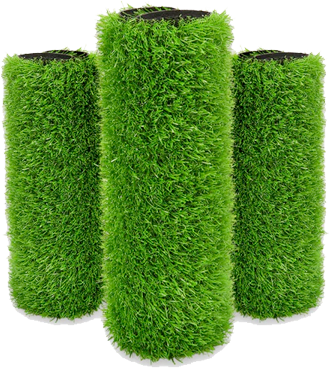More and more homeowners are choosing artificial grass because it looks great all year and saves a lot of time on upkeep.
No mowing, no watering, and no muddy patches — just a clean, green space that always looks neat.
In a city like London, where the weather changes all the time, having artificial turf means you can enjoy your garden without worrying about the rain or lack of sunlight.
It’s ideal for small gardens, rooftops, and even front lawns that don’t get much sun.
Families love it because it’s safe for kids and pets. It’s soft underfoot and easy to clean, so it works well for homes with busy outdoor spaces.
Whether you want to refresh your back garden or give your front lawn a modern look, quality artificial grass gives you a tidy, low-maintenance solution that fits any home.
This guide will help you pick the right type of turf for your space — from pile height and texture to drainage and durability — so you can choose the best artificial grass for your home or garden with confidence.
- So… Is Artificial Grass Truly Safe for Children?
- What Makes Artificial Grass Safe for Children?
- How to Create a Child-Safe Artificial Grass Play Zone
- FAQs: What Every Parent Wants to Know
- Can kids play barefoot on artificial grass?
- Will artificial grass give my child rug burns?
- What if my child spills food or gets sick on the grass?
- Is it safe for babies and toddlers?
- Does artificial grass smell?
- Is it safe under the playground equipment?
- Will it help with allergies?
- Does artificial grass get too hot in summer?
Table of Contents
ToggleUnderstanding the Different Types of Artificial Grass
Not all artificial grass is the same.
The best one for your home depends on where you plan to use it, how much foot traffic it’ll get, and the kind of look you want.
Some people prefer short, tidy turf for a neat garden, while others love the fuller, softer feel that looks like freshly grown grass.
Knowing what options are available makes it easier to find the perfect match for your garden or home.
By Purpose
- Landscaping turf: Great for general garden use and giving your outdoor space a natural look. It’s a versatile choice that works well for front gardens, backyards, and even side paths.
- Play turf: Designed for children or pets — strong, soft, and safe. It’s made to handle everyday activity while staying comfortable and long-lasting.
- Decorative turf: Perfect for balconies, patios, or small corners that need a touch of green. It instantly brightens up any dull space and adds a cosy, modern touch.
- Pet-friendly turf: Has fast drainage and resists odours, ideal for homes with dogs or cats. It’s easy to clean and keeps your outdoor area smelling fresh and hygienic.
By Pile Height
The pile height simply means how long the blades of grass are:
- Short (20–25mm): Best for small gardens or balcony areas — easy to clean and looks tidy. It keeps its shape well, even with furniture or regular use.
- Medium (25–35mm): A natural balance of softness and practicality, ideal for most gardens. It’s the most popular option for a realistic yet manageable lawn.
- Long (35–45mm+): Plush and realistic — a great choice for large lawns and premium installations. It gives that soft, luxurious look that feels great under bare feet.
By Texture and Material
Artificial grass can be made from a few different materials:
- Polyethylene (PE): Soft and realistic — feels closest to real grass. It’s a great option if you want a lush, natural look that’s comfortable to walk or sit on.
- Polypropylene (PP): A bit firmer and budget-friendly. It’s perfect for low-traffic areas or decorative spaces where you want greenery without the higher cost.
- Nylon: The most durable option, great for high-traffic areas or play spaces. It holds its shape extremely well and can handle all kinds of weather conditions.
Each material has its own look and feel, so it’s worth touching a few samples before you buy. That way, you’ll find turf that fits your garden’s style and how you plan to use it.
Latest Post to Read: Thinking About Switching to Artificial Grass? Honest Expert Answers to Your Top FAQs
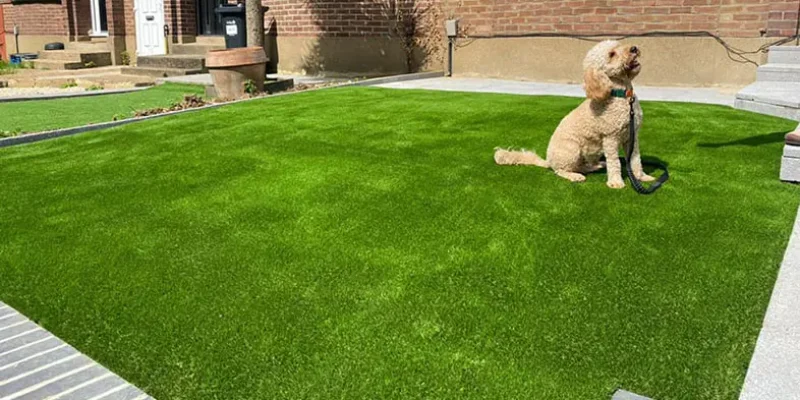
Key Factors to Consider When Choosing Artificial Grass
Once you’ve decided to go for artificial grass, the next step is choosing the right type for your home or garden.
There are a few important things to keep in mind that can make a big difference in how your lawn looks and lasts.
From how soft it feels to how well it handles the weather, here’s what to check before you buy.
1. Pile Height
The pile height affects how your turf looks and feels.
Shorter grass gives a neat, well-kept look, while longer piles feel softer and more natural underfoot.
If you want something that looks lush but is still easy to maintain, aim for a medium pile height between 25mm and 35mm — it’s the most popular choice for homes and gardens.
2. Density & Stitch Rate
The density, or how tightly the blades are stitched together, determines how thick and realistic the turf appears.
A higher stitch rate usually means a better-quality product that looks fuller and lasts longer.
Denser turf also feels more comfortable to walk on and keeps its shape better over time, especially in high-traffic areas.
3. Colour Tones
Not all green shades are the same.
The best artificial grass for gardens has a mix of light and dark green tones, sometimes with a bit of brown thatch at the base to imitate real grass.
Avoid turf that’s too bright or flat in colour — a natural blend will make your lawn look more realistic and fit better with your surroundings.
4. Drainage Quality
Good drainage is essential, especially in rainy cities like London.
A quality artificial turf should have holes or channels that let water pass through easily.
This prevents puddles, keeps your surface dry, and helps your lawn stay usable all year round — even after heavy rain.
5. UV Protection
Artificial grass spends its life outdoors, so UV protection is a must.
Turf with built-in UV resistance won’t fade or lose colour over time, even when exposed to direct sunlight.
This is particularly important for south-facing gardens or rooftop terraces that get strong daylight.
6. Backing Material & Durability
The backing holds everything together, so it’s worth checking the quality.
A strong, double-layered backing gives better stability and helps the turf keep its shape, even under regular use.
If you want a long-lasting lawn, make sure the backing feels firm but flexible — not thin or weak.
7. Warranty & Certification
Always look for turf that comes with a good warranty and meets UK safety standards.
Reputable suppliers usually offer 5 to 10 years of coverage, showing confidence in their product’s durability.
Certification also ensures your turf is non-toxic, lead-free, and safe for children and pets — giving homeowners peace of mind.
When you keep these factors in mind, you’ll know exactly how to choose the best artificial grass for your garden or home, one that looks great, feels natural, and stands up to years of use with minimal maintenance.
Also Read: What are the Pros and Cons of Artificial Grass with Dogs? (Dog Owner’s Guide 2025)
Choosing Artificial Grass for Your Garden Size & Purpose
Every home and garden is different, so it’s worth choosing your artificial grass based on how you plan to use the space.
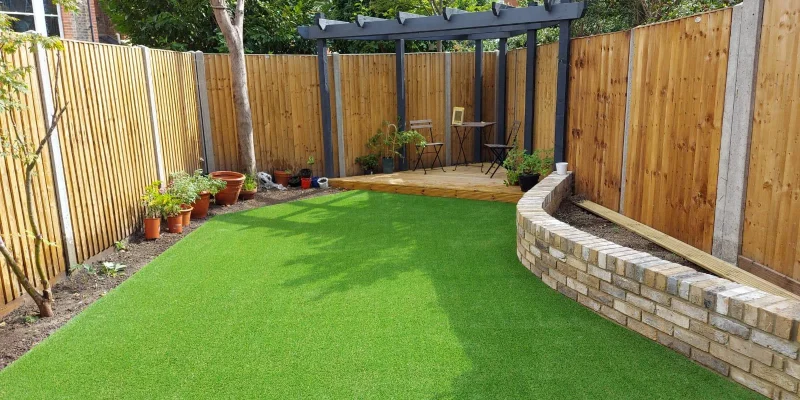
1. Small Gardens
If you’ve got a smaller garden, balcony, or patio, go for a short-pile artificial grass.
Shorter blades (around 20–25mm) make tight spaces look neat and open, while being easy to clean and maintain.
It’s perfect for artificial grass in small gardens because it gives that tidy, modern look without feeling overcrowded.
Even a small patch of green can make a big difference in brightening up your outdoor area.
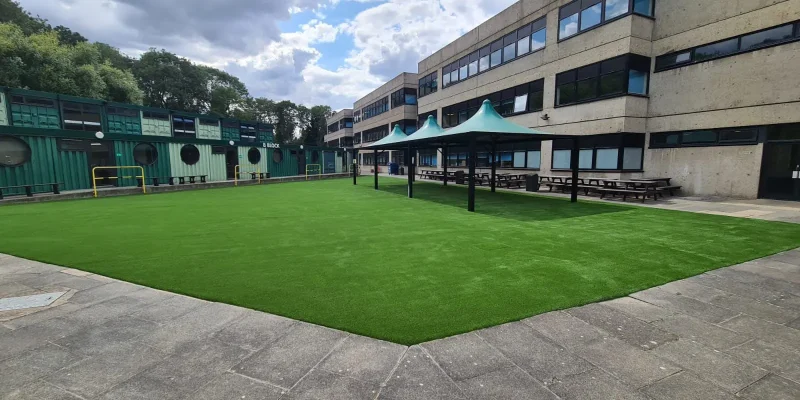
2. Large Lawns
For bigger gardens or open lawns, choose a dense, realistic turf with a natural mix of greens and a soft thatch layer underneath.
This type of artificial lawn looks more lifelike and gives your home that lush, fresh feel all year round.
The extra thickness also makes it comfortable for walking, playing, or simply relaxing outdoors. A quality artificial grass with medium to long pile height (30–40mm) works best for these spaces.
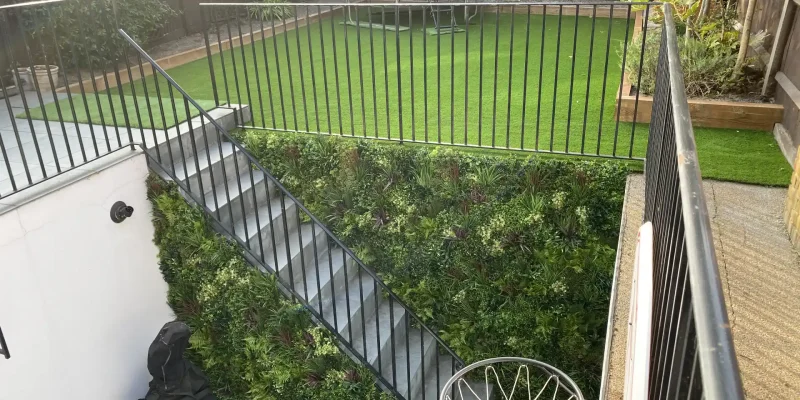
3. Balconies & Rooftops
If you’re transforming a balcony or rooftop terrace, go for a lightweight and drainable turf.
It’s easy to install, even on concrete or decking, and instantly adds warmth and colour to an otherwise hard surface.
Look for turf with good drainage backing so rainwater can pass through easily. This type of setup turns small balconies into cosy, low-maintenance green corners.
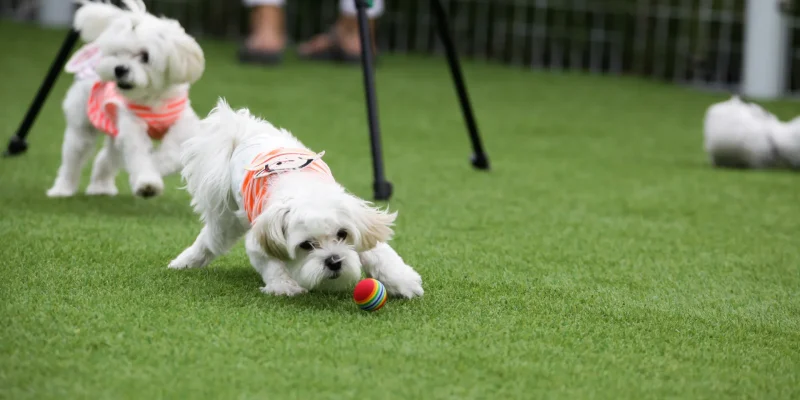
4. Pet Areas
Homes with pets need turf that’s odour-resistant and quick-draining.
Choose artificial grass for pets that has antibacterial protection and a backing designed for fast water flow — this keeps the surface clean and prevents smells from building up.
It’s soft enough for your furry friends to relax on, and sturdy enough to handle daily use without flattening.
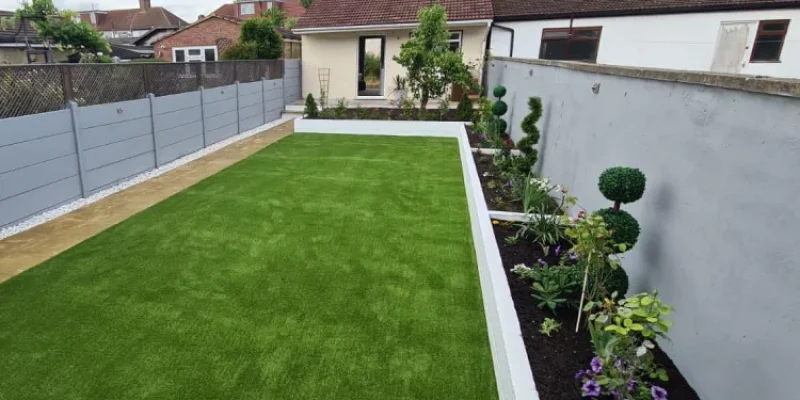
5. Family Spaces
If your garden is a family space where kids play and everyone spends time outdoors, safety and comfort come first.
Go for non-toxic, child-friendly artificial lawns that are soft underfoot and free from harmful chemicals.
Look for turf with good cushioning and durability so it can handle constant use. These artificial lawns for families create a safe, year-round play area that always looks neat — no mud, no mess.
By picking the right type for your garden size and purpose, you’ll get an outdoor space that looks beautiful and works perfectly for your lifestyle.
Also Read: Is Artificial Grass Safe for Kids? A Parent’s Guide
Installation Options: DIY vs. Professional Fitting
Once you’ve chosen the right artificial grass, the next step is installation. This can be done either as a DIY project or through professional fitting — and both have their advantages.
The right choice depends on your budget, experience, and how perfect you want the final finish to be.
DIY Installation
If you enjoy hands-on projects, installing DIY artificial turf can be a great weekend task.
For smaller areas like balconies, patios, or small back gardens, the process is fairly straightforward — clear the area, create a solid base, roll out the turf, and secure the edges.
The main benefit of doing it yourself is cost saving. You’ll avoid installation fees and have full control over the project timeline.
However, it’s important to make sure the base is even and well-drained. Poor preparation can lead to water pooling or uneven patches later on.
Taking your time with each step helps the turf look natural and last longer.
Professional Installation
For larger lawns or more complex spaces, it’s best to call in experts who know how to install artificial grass properly.
A professional team will prepare the base correctly, ensure good drainage, and make clean joins between turf sections. This gives your garden a smooth, natural finish that lasts for years.
At Superior Lawn, we offer artificial grass installation in London for all types of homes — from compact urban gardens to large family lawns.
Our team handles everything from ground preparation to fitting and finishing, ensuring your new turf looks perfect and drains properly.
We also provide product warranties and installation guarantees, so you can be confident your investment is protected.
Professional fitting may cost a bit more upfront, but it saves you time and ensures your lawn looks great right from the start.
With expert installation, you’ll enjoy a seamless finish, better performance, and peace of mind knowing your turf is built to last.
In short, If you’re confident with basic groundwork, DIY installation can work well for smaller spaces.
But if you want a polished, professional result with long-term reliability, hiring experienced installers is the smarter choice.
Must Read: How Much Does Artificial Grass Cost in London? 2025
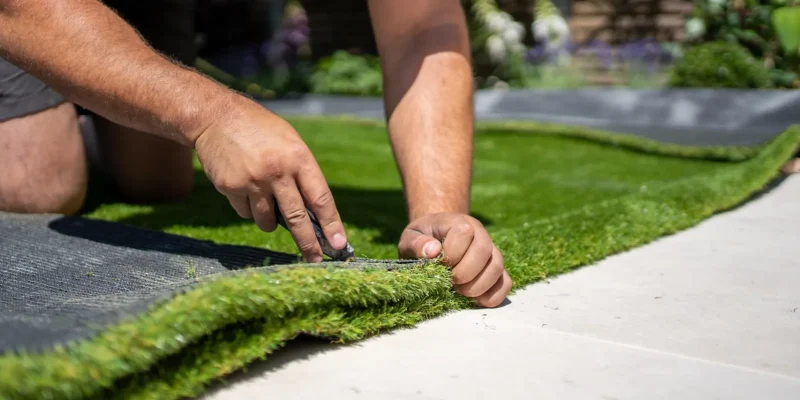
Eco-Friendly and Cost Benefits
One of the biggest advantages of switching to artificial grass is that it’s both eco-friendly and cost-effective over time.
Many homeowners are surprised by how much water, energy, and money they save once they make the change from natural lawns.
1. Water Conservation
With eco-friendly artificial grass, there’s no need for constant watering to keep your garden green.
In a city like London, this makes a big difference — you save thousands of litres of water each year while still enjoying a lush lawn that looks perfect through every season.
2. No Mowing, No Chemicals
Forget about mowing, fertilising, or spraying pesticides.
Unlike natural grass, artificial lawns don’t need harmful chemicals to stay healthy, which makes them safer for kids, pets, and the environment.
Less maintenance also means fewer tools, less noise, and less fuel used — it’s a win for both your wallet and the planet.
3. Sustainable and Recyclable Materials
Modern turf is made from recyclable materials and designed for long-term use.
Many newer products use eco-conscious backing systems and infills that can be recycled at the end of their life.
This focus on sustainability makes artificial turf a smart choice for homeowners who want a beautiful garden with minimal environmental impact.
4. Long-Term Savings
While the initial cost of artificial turf can be higher than natural grass, the long-term savings are clear.
With almost no upkeep costs — no water, fertiliser, or weekly mowing — your lawn pays for itself over time.
That’s one of the key benefits of artificial lawns: they stay green, neat, and durable for years without the ongoing expense of maintenance.
Switching to artificial turf isn’t just about convenience — it’s a greener, smarter way to enjoy your outdoor space while saving money and reducing your environmental footprint.
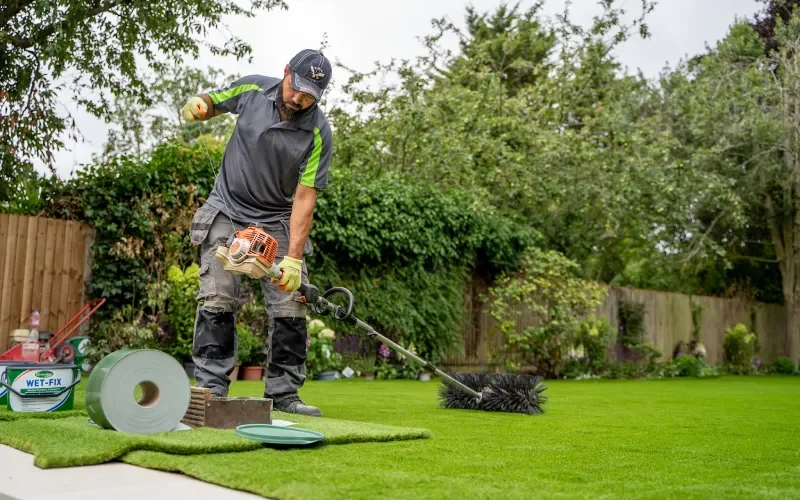
Why Buy Astro Turf from a Local Supplier in London
When it comes to finding the right artificial grass, working with a local supplier in London can make all the difference.
From expert advice to quicker delivery and installation, local knowledge adds real value to your project.
1. Faster Delivery and Personal Service
Buying from a local turf company means faster turnaround times and easier communication.
If you need help choosing a product or want your installation done quickly, a nearby team can visit your property, take measurements, and get your new turf fitted sooner.
2. Expert Advice for London Homes
Local suppliers understand the challenges of London gardens — from limited sunlight and compact spaces to heavy rainfall.
That means you’ll get advice on the best turf type for your location, ensuring your lawn stays green and practical all year round.
3. See Before You Buy
Choosing artificial grass is much easier when you can see and feel the product first-hand.
Local suppliers often have showrooms or sample displays where you can compare different styles, colours, and textures before making a decision.
It’s the best way to make sure your new lawn matches your home’s style and feels just right underfoot.
4. Support Local Business
Buying locally also means supporting the community.
At Superior Lawn, we’re proud to be a trusted artificial grass London supplier, offering a full range of products and services for homeowners across the city.
From mid-range to premium astro turf, we help every customer find the right fit for their budget and space.
Our team handles everything from product advice to professional installation, ensuring your lawn looks flawless from day one.
So whether you’re planning a complete garden makeover or just want to replace your old turf, Superior Lawn offers the best artificial turf service for London residences — reliable, high-quality, and locally trusted.
Conclusion: Make the Smart Choice for Your Home
Artificial grass is an easy, long-lasting way to keep your garden looking great all year.
It saves time, reduces maintenance, and adds value to your home with a clean, natural look that never fades.
By choosing the right turf and a trusted London supplier, you’ll get a lawn that fits your space and lifestyle perfectly.
Contact Superior Lawn today for a free survey or installation quote and enjoy a beautiful, low-maintenance lawn that lasts for years.
Frequently Asked Questions related to Artificial Grass
What is the best type of artificial grass for a home garden?
The best type depends on your space and usage. For example:
- Small gardens or balconies: Shorter pile (20–30mm) and lightweight turf.
- Play areas or family gardens: Dense, soft, non-toxic grass.
- Pet-friendly homes: Turf with efficient drainage and odour resistance.
How do I know if artificial grass is good quality?
Look for:
- High density and realistic multi-tone colour.
- Strong backing with drainage holes.
- UV protection and at least 8-year warranty.
How long does artificial grass last in a home garden?
With proper care, quality artificial turf can last 10 to 15 years — even longer in shaded or low-traffic areas. Longevity depends on the product quality, installation method, and maintenance routine.
Can artificial grass handle London’s weather?
Yes — modern artificial turf is designed for rainy and variable UK climates.
Look for turf with good drainage backing and UV protection to prevent waterlogging and fading over time.
Do I need to clean or maintain artificial grass?
Minimal maintenance is needed:
- Brush the surface occasionally to lift fibres.
- Remove debris like leaves.
- Rinse if pets use the area.
No mowing, fertilising, or watering is required — perfect for busy homeowners.
Is artificial grass safe for children and pets?
Yes — most modern products are non-toxic, lead-free, and soft underfoot.
Choose certified turf that meets UK safety standards, especially for play or pet areas.
Can I install artificial grass myself?
Yes, smaller areas can be DIY-installed, but for long-term results, professional installation ensures proper base preparation, leveling, and drainage — especially in uneven London gardens.
How much does artificial grass cost in London?
Costs vary by quality and size, typically ranging from £25–£60 per m² installed. DIY installation is cheaper, but professional fitting provides better finish and longevity.
Can artificial grass be used indoors or on balconies?
Absolutely. It’s popular for balconies, terraces, patios, and even indoor spaces like home gyms or play areas. Lightweight, short-pile turf is ideal for these settings.
Is artificial grass eco-friendly?
It’s more sustainable than many expect — it reduces water use, eliminates the need for chemicals or fertilisers, and some suppliers (like your business) offer recyclable or eco-base options.


